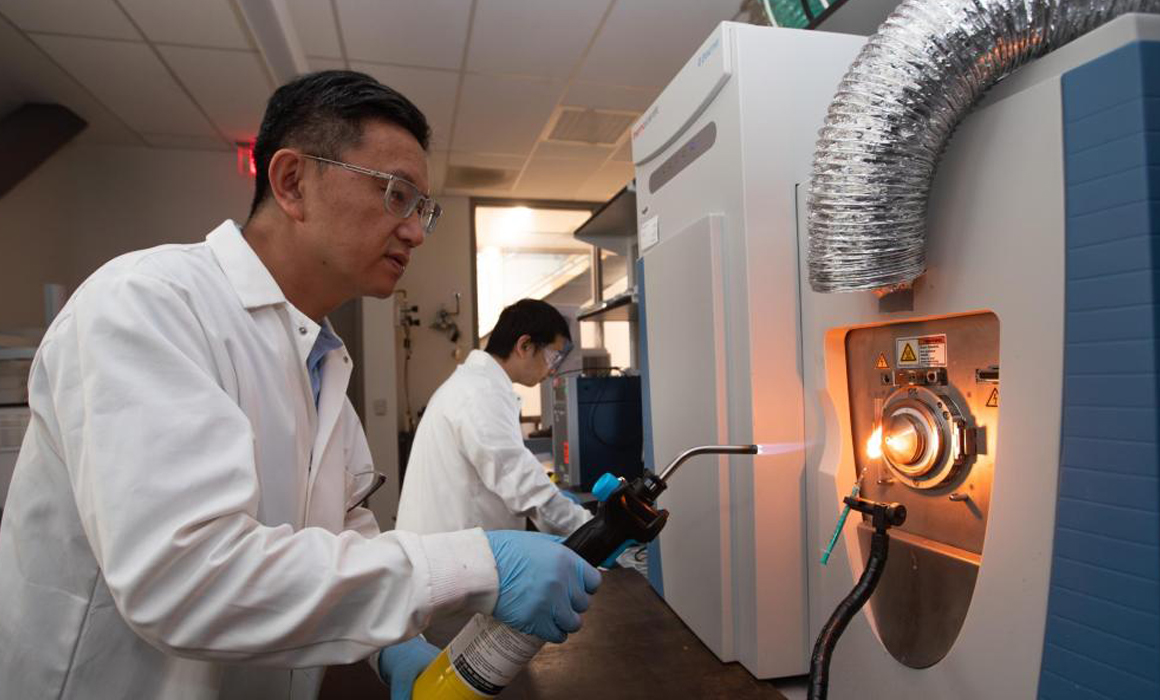Finding Nano Plastics in Seconds: A New Ultra-fast Test
NJIT Researchers Develop Rapid Method to Detect Micro- and Nanoplastics in Seconds
Microplastics and nanoplastics — tiny fragments shed from everyday plastic products — are increasingly found in our food, water, soil and even inside the human body. Their accumulation has been linked to fertility issues, metabolic disorders and other potential health risks in animal models. Yet detecting these pollutants has remained a time-consuming challenge.
To combat this challenge, researchers at New Jersey Institute of Technology and Rutgers have developed a powerful new method that can detect microplastics and nanoplastics in as little as 10 seconds, using a streamlined approach called Flame Ionization Mass Spectrometry (FI-MS).
The research, recently published in Journal of Hazardous Materials, shows that the technique can detect sub-microgram levels of plastic pollution in a wide range of samples, including bottled water, apple juice, agricultural soil and biological tissue. In one striking example, the team identified polystyrene nanoplastics in mouse placental tissue — a feat typically requiring complex chemical digestion and separation.
“It is amazing to have a method that can detect plastics in 1 milligram of tissue without time consuming sample prep,” said Genoa Warner, assistant professor in NJIT’s Department of Chemistry and Environmental Science and a co-author on the study.
Warner, who runs the Laboratory of Endocrine Disruption & Chemical Biology (EDC Lab), investigates the toxicity and mechanisms of endocrine disrupting chemicals in biological systems. She plans to use FI-MS to measure plastics in tissue samples.
“Traditional detection methods require hours or even days of sample preparation,” said Hao Chen, professor of chemistry and environmental science at NJIT, and lead author of the study. “With FI-MS, we can skip all of that. You can burn a dried sample — soil, tissue, even filter paper from water — and immediately detect trace plastics by their molecular fingerprint.”
The speed and simplicity of FI-MS could make it a valuable tool for both researchers and policymakers. While agencies like the EPA have yet to establish regulatory limits for microplastics in drinking water, rapid detection methods like this could help lay the groundwork for future public health standards.
“There are few techniques or methodologies currently available to accurately and consistently measure the micro/nanoplastic concentrations in environmental or biological samples,” said Phoebe Stapleton, co-author of the study and associate professor in the Pharmacology and Toxicology Department of the Ernest Mario School of Pharmacy at Rutgers University. “Understanding those concentrations is vital to studying the toxicology of micro- and nanoplastic exposures.
“Those tools that do exist are expensive to acquire and may be out of reach for many groups. This technique provides a viable alternative for the measurement of plastics.”
Unlike other mass spectrometry techniques, FI-MS uses a small open flame to simultaneously break down and ionize plastic particles at the point of analysis. The resulting ions are captured and analyzed by a high-resolution mass spectrometer, allowing researchers to identify the type and quantity of plastic without elaborate cleanup.
“Our method offers both speed and sensitivity, as it avoids sample loss and contamination during preparation,” said Mengyuan Xiao, a Ph.D. student in Chen’s research group. “And it also allowed quantitative analysis of microplastics and nanoplastics in soil and tissue samples.”
Chen’s lab has filed a patent for the FI-MS technique, and is currently exploring commercial applications with instrumentation partners. The group is also developing rapid methods for the detection of per- and polyfluoroalkyl substances (PFAS), another group of harmful environmental contaminants.
Looking ahead, the team plans to expand the method to analyze plastic accumulation in biological samples such as blood and brain tissue — work that could help illuminate the long-term health effects of microplastic exposure.
“The public doesn’t always realize how easy it is to ingest microplastics,” said Chen. “Using hot liquids in plastic bottles or heating food in plastic containers can release particles directly into what you eat. The more we can measure and understand these exposures, the better we can protect human health.”
This work is supported by the National Science Foundation, the National Institutes of Health, Herbert W. Hoover Foundation and an NJIT faculty seed grant.
This research was conducted by Chen’s group at NJIT (Mengyuan Xiao, Yongqing Yang, Terry Yu, Jerry Liu, Alex Guo), in collaboration with Warner’s group at NJIT (Hanin Alahmadi, Allison Harbolic, Genoa Warner) and Stapleton’s group at Rutgers University (Gina Moreno, Phoebe Stapleton).
The Hoover W. Hoover Foundation partially funded this project and innovation. For more information, please visit: https://news.njit.edu/njit-researchers-develop-rapid-method-detect-micro-and-nanoplastics-seconds

